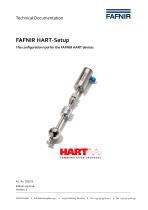
Oil separator monitoring system COMScontinuous



Add to favorites
Compare this product
Characteristics
- Applications
- for oil separator
- Other characteristics
- continuous
Description
Continuous Oil-Separator Monitoring System (COMS)
The first of its kind solution for the continual monitoring of oil separators for the thickness of the oil layer and the content of sludge.
The complete COMS solution from FAFNIR is comprised of the new sophisticated ultra-sonic sludge sensor, which is suspended in the oil separator taking readings continually to measure the height and temperature of sludge in the reservoir. Alongside with the ultra-sonic sensor is the VISY-Stick with a special separation float monitoring the thickness of the oil level. These two readings combined give the complete picture of the contents of the oil separator, something which has, until now, only been achievable manually. The readings will be visualized by the VISY-Command GUI/Web and permanently stored in the operations diary. The VISY-Command Web can additionally be relayed to the SECON-X server for remote server based access anytime anywhere.
Features
• - Continuously monitors the thickness of the oil
• - Continuously monitors sludge layer thickness in the reservoir
• - Self-monitoring
• - Alarms with email alerts
• - Detailed real-time data for reporting and analysis
• - High quality stainless steel construction
• - Easy to retrofit with an existing VISY-X ATG-System
• - Integrated oil separator alarm indicator (oil layer thickness / overfill)
• - Integrated operations diary
Catalogs
Exhibitions
Meet this supplier at the following exhibition(s):
*Prices are pre-tax. They exclude delivery charges and customs duties and do not include additional charges for installation or activation options. Prices are indicative only and may vary by country, with changes to the cost of raw materials and exchange rates.




